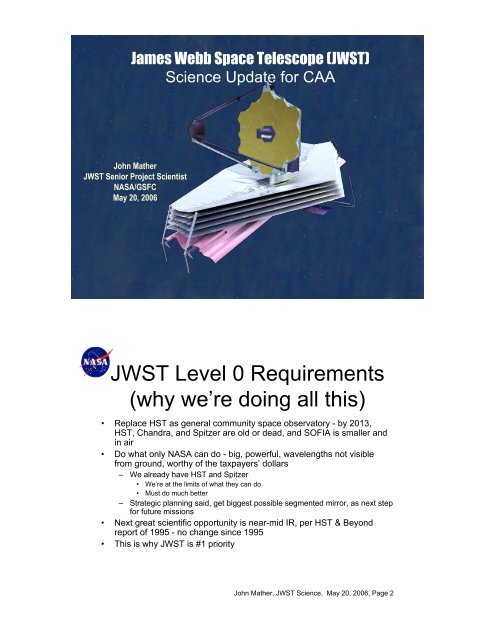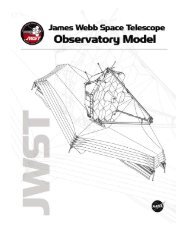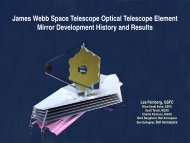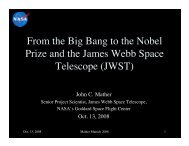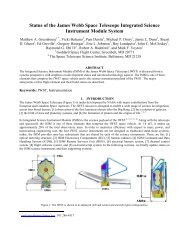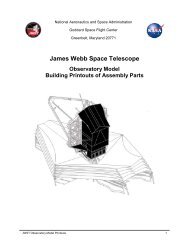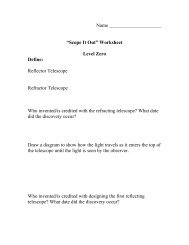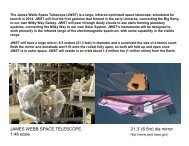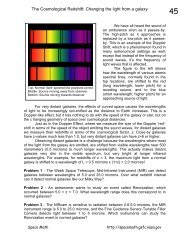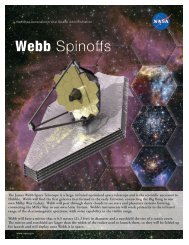JWST Level 0 Requirements - James Webb Space Telescope - NASA
JWST Level 0 Requirements - James Webb Space Telescope - NASA
JWST Level 0 Requirements - James Webb Space Telescope - NASA
- No tags were found...
Create successful ePaper yourself
Turn your PDF publications into a flip-book with our unique Google optimized e-Paper software.
<strong>JWST</strong> Science Objectives versus Cosmic HistoryStar & PlanetFormationGalaxiesEvolveOrigin of Life &IntelligenceFirst GalaxiesAtoms &RadiationParticlePhysicsBigBangNow3 minutes• Study the birth and evolution of galaxies- See “First Light Objects”- Galaxy formation• Study star and planet formation- Coronagraphs will study debris disksand Extrasolar Giant Planets- Transit spectroscopy of planets380,000years200 millionyears1 billion years13.7 billion yearsJohn Mather, <strong>JWST</strong> Science, May 20, 2006, Page 5End of the dark ages: first light and reionization• What are the first galaxies (beyond thoseseen by Hubble at z = 6)?• When did reionization occur?– Once or twice?• What sources caused reionization?RedshiftNeutral intergalactic mediumz~zzz i.i• Ultra-deep field• Spectrum of distant quasars• Studies of faint galaxiesWavelength Wavelength WavelengthLyman ForestAbsorptionPatchyAbsorptionBlack Gunn-Peterson troughJohn Mather, <strong>JWST</strong> Science, May 20, 2006, Page 6
Planetary systems and the origins of life• How do planets form?<strong>JWST</strong> (20 µm)Spitzer (24 µm)Visible (HST)• Are exosolar systems like our own?• How are habitable zones established?• Detection of planets via debris disks– Directly image very young planets– Indirectly detect planets via theirfootprints in debris disksFomalhautTitan• Exosolar giant planets– direct imaging by blocking star’s light• Spectra of organic molecules in disks,comets and Kuiper belt objects in outersolar system• Atmospheric composition of exosolar planets– Observe transits of planetsJohn Mather, <strong>JWST</strong> Science, May 20, 2006, Page 9<strong>JWST</strong> characterizes transiting planetsHST: planet transits star• Transit light curves• Kepler extrasolar giant planetsSpitzer: planet passes behind star• Transit Spectroscopy• Terrestrial planets around M stars• Atmospheres of Kepler giant planetsJohn Mather, <strong>JWST</strong> Science, May 20, 2006, Page 10
Confirmation of Kepler Planet Candidates• Examples of <strong>JWST</strong> S/N = 35 transitdetections– Earth-sized planet orbiting a sun-likestar at 1 AU at Kepler star distances(transit time 13h, d=300 pc)– Earth-size moon around HD209458b(transit time 3 h, d=47 pc)1R ! @ 1AU1. Aperture is key (Det. Lim. regime)• S/N ~ D 2 ~ Collecting Area<strong>JWST</strong> 25 m 2 collecting areaHST 4.5 m 2 collecting area(<strong>JWST</strong> has 6x more)Spitzer 0.57 m 2 (<strong>JWST</strong> 40x)Kepler 0.71 m 2 (<strong>JWST</strong> 30x)2. <strong>Space</strong> is stableHigh dynamic range photometry10 -4 – 10 -5 possibleThe four sections of a simulated light curvecontaining the transits of an Earth-sizeplanet (1.0 R e ) are folded at the correctperiod, with the sum shown in red. Thepresence of the transit is unmistakable.http://www.kepler.arc.nasa.gov/Courtesy: Seager (2005) & Astrobiology and<strong>JWST</strong> (contributed by R. Gilliland) 11Each HST Instrument Is the Equivalent of an Explorer or Mid-Ex MissionInstrument Class Year Flown Cost ($M)1P.I. or Science Team LeaderWFPC1 P.I. 1990FOS P.I. 1990FOC Facility 1990GHRS P.I. 1990HSP P.I. 1990FGS/ Astrometry Facility 1990, 1997WFPC2 Facility 1993NICMOS P.I. 1997STIS P.I. 1997ACS P.I. 2002COS P.I. 2007?WFC3 Facility 2007?196.5110N/A114.825.5N/A158.2156.2185.578.481.5 2126.2 2J. Westphal, Cal TechR. Harms, UCSDF. Macchetto, ESAJ. Brandt, GSFCR. Bless, U. WisconsinW. Jefferies, U. TexasJ. Trauger, JPLR. Thompson, U. ArizonaB. Woodgate, GSFCH. Ford, JHUJ. Green, U. ColoradoR. O'Connell, U. Virginia1. Cost escalated to FY 2006 dollars, includes instrument development only. Funding for post-launch science team (GTO)investigations book-kept separately.2. Includes Full Cost Accounting beginning in FY’04.John Mather, <strong>JWST</strong> Science, May 20, 2006, Page 12
The Importance of Flagship Missions Was Emphasized in the 2000NAS/NRC/CAA Report“Federal Funding for Astronomical Research”“The continuing growth in funding for astronomy in the 1980’s and1990’s has been largely the result of the success of <strong>NASA</strong>’s spacescience program, in particular the launch of <strong>NASA</strong>’s GreatObservatories and several midsized facility-class satellites.”“HST GO and GTO funding currently represents ~30% of the totaldirect grant funding to the U.S. astronomical community. Much ofthis money funds Ph.D. astronomers, graduate students , andinstitutional technical support staff....”“Most important is that a significant fraction of the support for theyoungest members of the field comes from such missions. The impact[of loss of a major mission] on the youngest astronomers, such asthose supported by CGRO, Hubble, and Chandra fellowships andthose supported by the R&A funds for such missions, would bedisproportionately large and would significantly alter the future ofthe field.”John Mather, <strong>JWST</strong> Science, May 20, 2006, Page 13<strong>JWST</strong> in Context• Enormous scientific breakthroughs possible• Next logical step after HST– 7x larger collecting area, optimized for infrared that HST can’t see– Thousands of times faster observations– Extends science & international partnership• Builds on Spitzer IR heritage– 50 x collecting area, much bigger & better detectors– Angular resolution of HST• Synergy with planned giant ground-based telescopes• Essential part of planet program - transits, coronography, dustdisks, solar system• Technology legacy for future missions - detectors, optics,wavefront sensing, adjustment, deployment, coolersJohn Mather, <strong>JWST</strong> Science, May 20, 2006, Page 14
Summary• Top priority in astronomy and astrophysics, per NationalAcademy of Sciences and <strong>JWST</strong> Science Assessment Team• Revolutionary paradigm-shifting science in 4 major areas:– First light– Galaxy formation– Star and planet formation– Planetary systems and conditions for life• Shared facility enables university science– Provide data to HST and Spitzer users– ~ 200 projects each year– Archive and observing grants planned for ~ $250M in 10 year life• Risks are well managed– Cost, schedule, technology, science• Every reason to expect that public will take ownership of <strong>JWST</strong>just as with HSTJohn Mather, <strong>JWST</strong> Science, May 20, 2006, Page 15<strong>JWST</strong> Science Backup ChartsJohn Mather, <strong>JWST</strong> Science, May 20, 2006, Page 16
Brief History of <strong>JWST</strong> Science• 1989 conference, wanted UV telescope much larger than HST• 1990, HST launched• 1995, HST & Beyond report, wanted IR telescope > 4 m, optimized for 1-5microns; project study started; objectives from first light to planets• 1996, 8 m baselined (50 m 2 )• 2002, descoped area by half to 25 m 2 ; accepted by CAA• 2002, Northrop Grumman selected with 29.7 m 2• 2003, Spitzer <strong>Space</strong> <strong>Telescope</strong> launched, showed very early universe bright inIR, observed dust disks around stars, proved need for mid IR on <strong>JWST</strong>• 2003, WMAP showed universe lit up very early, redshift ~ 17, moved the goal forthe First Light studies to much longer wavelengths• 2003, <strong>JWST</strong> descoped to 25 m 2 , smaller instruments; selected beryllium mirrors• 2005, deleted tunable filter module, descoped performance at wavelengths < 1.7microns overlapping with GSMT on ground, relaxed contaminationrequirements, per Science Assessment Team• 2006, new WMAP results confirm first results, early first light, redshift easier toreach (z ~ 12)• 2006, planet transits recognized as major <strong>JWST</strong> target, including Earthlikeplanets around M dwarf starsJohn Mather, <strong>JWST</strong> Science, May 20, 2006, Page 17<strong>JWST</strong> Science Assessment Team, 2005• “The international scientific community is unanimous in regarding the <strong>James</strong><strong>Webb</strong> <strong>Space</strong> <strong>Telescope</strong> as the highest priority facility for the US and theinternational community to advance astrophysical understanding”• “…the case for the telescope and its unique capabilities has grown in strengthand astronomical significance.”• “<strong>JWST</strong> is the only facility planned for the next two decades with the resolutionand sensitivity in the thermal infrared needed to address the nature of First Lightdirectly.”• “[<strong>JWST</strong>]… is positioned to uniquely contribute to the great question: “Throughoutthe universe, how common are the life generating processes [that] took placealmost 4 billion years ago in our solar system?”• “<strong>JWST</strong> will therefore be our opportunity to open the window wide to the nature ofthe fantastically diverse extrasolar planets …”• “<strong>JWST</strong> offers the only IR mission capable of studying extra solar planetarysystems this decade”• Ground-based capabilities are growing at wavelengths < 1.7 !m with plans forGSMT, so relax performance requirements for <strong>JWST</strong> where there is overlapJohn Mather, <strong>JWST</strong> Science, May 20, 2006, Page 18
COBE Lessons Learned for <strong>JWST</strong>• It’s the detectors, stupid!– Early investment in upgrades to HST & Spitzer detectors– Development of cryogenic ASICs to limit noise pickup• Parts and materials properties must be measured for the exact designs,materials, adhesives, and joining processes used– Extensive test programs, TRL-6 by January 2007• Contamination control to unknown requirements is infinitely expensive– Relaxed contamination requirements per SAT review– Detailed stray light and contamination modeling being done– Stray light is not dominated by dust scattering but by unwanted light gettingpast baffles, so more cleanliness doesn’t help much• Almost all cryo tests have to be repeated– Use pathfinders and Engineering Test Units to find problems early and workout the procedures before risking flight hardware– Plan for very long integration and test program with lots of contingency• Reworking software from one computer system to another is very costly– Provide single system from the beginningJohn Mather, <strong>JWST</strong> Science, May 20, 2006, Page 19


